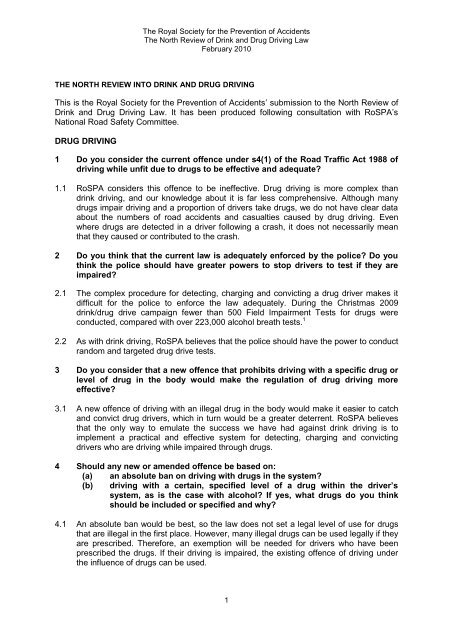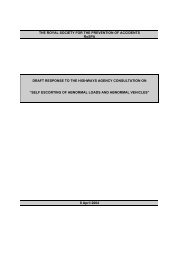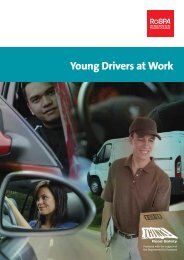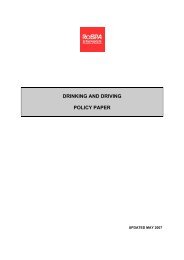The North Review of Drink and Drug Driving Laws - RoSPA
The North Review of Drink and Drug Driving Laws - RoSPA
The North Review of Drink and Drug Driving Laws - RoSPA
You also want an ePaper? Increase the reach of your titles
YUMPU automatically turns print PDFs into web optimized ePapers that Google loves.
<strong>The</strong> Royal Society for the Prevention <strong>of</strong> Accidents<br />
<strong>The</strong> <strong>North</strong> <strong>Review</strong> <strong>of</strong> <strong>Drink</strong> <strong>and</strong> <strong>Drug</strong> <strong>Driving</strong> Law<br />
February 2010<br />
THE NORTH REVIEW INTO DRINK AND DRUG DRIVING<br />
This is the Royal Society for the Prevention <strong>of</strong> Accidents’ submission to the <strong>North</strong> <strong>Review</strong> <strong>of</strong><br />
<strong>Drink</strong> <strong>and</strong> <strong>Drug</strong> <strong>Driving</strong> Law. It has been produced following consultation with <strong>RoSPA</strong>’s<br />
National Road Safety Committee.<br />
DRUG DRIVING<br />
1 Do you consider the current <strong>of</strong>fence under s4(1) <strong>of</strong> the Road Traffic Act 1988 <strong>of</strong><br />
driving while unfit due to drugs to be effective <strong>and</strong> adequate?<br />
1.1 <strong>RoSPA</strong> considers this <strong>of</strong>fence to be ineffective. <strong>Drug</strong> driving is more complex than<br />
drink driving, <strong>and</strong> our knowledge about it is far less comprehensive. Although many<br />
drugs impair driving <strong>and</strong> a proportion <strong>of</strong> drivers take drugs, we do not have clear data<br />
about the numbers <strong>of</strong> road accidents <strong>and</strong> casualties caused by drug driving. Even<br />
where drugs are detected in a driver following a crash, it does not necessarily mean<br />
that they caused or contributed to the crash.<br />
2 Do you think that the current law is adequately enforced by the police? Do you<br />
think the police should have greater powers to stop drivers to test if they are<br />
impaired?<br />
2.1 <strong>The</strong> complex procedure for detecting, charging <strong>and</strong> convicting a drug driver makes it<br />
difficult for the police to enforce the law adequately. During the Christmas 2009<br />
drink/drug drive campaign fewer than 500 Field Impairment Tests for drugs were<br />
conducted, compared with over 223,000 alcohol breath tests. 1<br />
2.2 As with drink driving, <strong>RoSPA</strong> believes that the police should have the power to conduct<br />
r<strong>and</strong>om <strong>and</strong> targeted drug drive tests.<br />
3 Do you consider that a new <strong>of</strong>fence that prohibits driving with a specific drug or<br />
level <strong>of</strong> drug in the body would make the regulation <strong>of</strong> drug driving more<br />
effective?<br />
3.1 A new <strong>of</strong>fence <strong>of</strong> driving with an illegal drug in the body would make it easier to catch<br />
<strong>and</strong> convict drug drivers, which in turn would be a greater deterrent. <strong>RoSPA</strong> believes<br />
that the only way to emulate the success we have had against drink driving is to<br />
implement a practical <strong>and</strong> effective system for detecting, charging <strong>and</strong> convicting<br />
drivers who are driving while impaired through drugs.<br />
4 Should any new or amended <strong>of</strong>fence be based on:<br />
(a) an absolute ban on driving with drugs in the system?<br />
(b) driving with a certain, specified level <strong>of</strong> a drug within the driver’s<br />
system, as is the case with alcohol? If yes, what drugs do you think<br />
should be included or specified <strong>and</strong> why?<br />
4.1 An absolute ban would be best, so the law does not set a legal level <strong>of</strong> use for drugs<br />
that are illegal in the first place. However, many illegal drugs can be used legally if they<br />
are prescribed. <strong>The</strong>refore, an exemption will be needed for drivers who have been<br />
prescribed the drugs. If their driving is impaired, the existing <strong>of</strong>fence <strong>of</strong> driving under<br />
the influence <strong>of</strong> drugs can be used.<br />
1
<strong>The</strong> Royal Society for the Prevention <strong>of</strong> Accidents<br />
<strong>The</strong> <strong>North</strong> <strong>Review</strong> <strong>of</strong> <strong>Drink</strong> <strong>and</strong> <strong>Drug</strong> <strong>Driving</strong> Law<br />
February 2010<br />
5 If a new <strong>of</strong>fence is created for some drugs, does the existing <strong>of</strong>fence <strong>of</strong> driving<br />
under the influence <strong>of</strong> drugs need to be retained for others?<br />
5.1 <strong>The</strong> existing <strong>of</strong>fence would still be needed for drugs (legal or illegal) that were not<br />
encompassed by the new <strong>of</strong>fence.<br />
6 Do you consider that any new <strong>of</strong>fence should apply to:<br />
(a) all controlled drugs (eg heroin, cannabis, cocaine)?<br />
(b) prescribed or over the counter drugs which are used inappropriately or<br />
may otherwise have impairing effects?<br />
6.1 Including all illegal drugs listed in the Misuse <strong>of</strong> <strong>Drug</strong>s Act 1971 may not be practical<br />
because it would require a wide variety <strong>of</strong> testing regimes, which would be unwieldy<br />
<strong>and</strong> expensive. <strong>The</strong>refore, the <strong>of</strong>fence should apply to illegal drugs that have been<br />
shown to impair driving.<br />
6.2 <strong>The</strong> new <strong>of</strong>fence should not apply to prescribed or over-the-counter medicines,<br />
because some people may be deterred from taking the medicines that they need.<br />
Including prescribed <strong>and</strong> over-the-counter medicines would make the new <strong>of</strong>fence little<br />
different from the existing one, <strong>and</strong> the benefit <strong>of</strong> making it easier to catch <strong>and</strong> convict<br />
drivers with illegal drugs in their bodies would be lost.<br />
6.3 It is difficult to predict whether a medicine might impair one’s driving because the sideeffects<br />
vary between people, <strong>and</strong> the advice given on the medicines <strong>and</strong> by doctors<br />
<strong>and</strong> pharmacists is <strong>of</strong>ten not clear (for example, "may cause drowsiness"). A driver<br />
may not realise that their driving has been impaired by their medicine(s) until it is too<br />
late, as the impairment may be gradual <strong>and</strong> subtle. Better education is needed about<br />
the effects <strong>of</strong> medicines on driving, <strong>and</strong> the medical pr<strong>of</strong>ession, <strong>and</strong> pharmaceutical<br />
suppliers, need to improve the advice they provide.<br />
6.4 Individuals need to be responsible for deciding whether they are fit to drive, <strong>and</strong> where<br />
they get this substantially wrong, the existing <strong>of</strong>fence <strong>of</strong> driving under the influence <strong>of</strong><br />
drugs could be used.<br />
7 Do you think that the law should also specifically address impairment caused by<br />
combining drugs with alcohol?<br />
7.1 <strong>RoSPA</strong> does not think that an <strong>of</strong>fence <strong>of</strong> driving with alcohol <strong>and</strong> drugs is necessary.<br />
We are not clear what additional benefits would be gained. <strong>The</strong> penalties would have<br />
to be more severe than for drink driving or drug driving alone, <strong>and</strong> the police would<br />
need to conduct both alcohol <strong>and</strong> drug tests which would have resource implications.<br />
8 What is your view on compulsory drug testing <strong>of</strong> all drivers involved in fatal (or<br />
serious) road accidents?<br />
8.1 Compulsory drug testing <strong>of</strong> drivers in fatal or serious accidents should be introduced.<br />
2
<strong>The</strong> Royal Society for the Prevention <strong>of</strong> Accidents<br />
<strong>The</strong> <strong>North</strong> <strong>Review</strong> <strong>of</strong> <strong>Drink</strong> <strong>and</strong> <strong>Drug</strong> <strong>Driving</strong> Law<br />
February 2010<br />
9 Do you think that there are any legal or procedural barriers to securing a<br />
conviction for drug-driving? What alternatives or improvements can you<br />
suggest?<br />
9.1 <strong>The</strong> procedure is too complicated. A police <strong>of</strong>ficer must establish a person’s driving is<br />
impaired, <strong>and</strong> that drugs may be the reason, arrest the driver, arrange for a Forensic<br />
Medical Examiner to certify that drugs may be present <strong>and</strong>, if so, take a sample for<br />
toxicological analysis.<br />
10 What is your knowledge <strong>and</strong> view <strong>of</strong> available drug testing equipment?<br />
10.1 <strong>The</strong>re have been attempts to develop a roadside drug tester for well over 20 years, but<br />
it has still not been possible to produce a device that can be type approved. We do not<br />
believe that changes to drug driving laws should depend upon such equipment<br />
becoming available.<br />
11 Do you consider that the procedures for drug testing at the police station<br />
(including the role <strong>of</strong> the Forensic Medical Examiner) need to be improved?<br />
11.1 We underst<strong>and</strong> that it is normal for a nurse to be present in custody suites. If so, the<br />
feasibility <strong>of</strong> nurses certifying the presence <strong>of</strong> drugs <strong>and</strong> taking samples should be<br />
investigated.<br />
3
<strong>The</strong> Royal Society for the Prevention <strong>of</strong> Accidents<br />
<strong>The</strong> <strong>North</strong> <strong>Review</strong> <strong>of</strong> <strong>Drink</strong> <strong>and</strong> <strong>Drug</strong> <strong>Driving</strong> Law<br />
February 2010<br />
ALCOHOL<br />
1 Do you think that the current prescribed blood alcohol limit <strong>of</strong> 80mg/100ml<br />
should be reduced to 50mg/100ml or less?<br />
1.1 <strong>RoSPA</strong> believes that the limit should be lowered to 50 mg.<br />
1.2 Despite 30 years <strong>of</strong> drink drive education <strong>and</strong> enforcement, around 100,000 people<br />
are still caught drink driving annually, <strong>and</strong> 8 people die in drink drive accidents every<br />
week. 2<br />
1.3 <strong>The</strong> current limit was based on evidence that the likelihood <strong>of</strong> a road accident rises<br />
sharply at <strong>and</strong> above that level. However, the evidence also showed that most drivers<br />
are impaired <strong>and</strong> their risk increases below this limit.<br />
1.4 <strong>The</strong> Scottish Government has called for the power to set the drink drive limit in<br />
Scotl<strong>and</strong> if it is not lowered in Engl<strong>and</strong> <strong>and</strong> Wales. 3 <strong>The</strong> majority (79%) <strong>of</strong> people in<br />
Scotl<strong>and</strong> support a lower limit. 4 <strong>The</strong> limit should be reduced for the whole UK, but<br />
<strong>RoSPA</strong> would support one just in Scotl<strong>and</strong>, if necessary, in the hope that this would<br />
lead the way.<br />
1.5 Although, the ideal limit is zero alcohol, <strong>RoSPA</strong> does not believe that this is literally<br />
possible <strong>and</strong> certainly not achievable in a single leap from the current limit <strong>of</strong> 80mg.<br />
<strong>The</strong>refore, we think the best option is a reduction to 50 mg.<br />
2 Do you think that the current penalty regime for drink driving <strong>of</strong>fences is<br />
sufficient?<br />
2.1 <strong>RoSPA</strong> believes that the current level <strong>of</strong> penalties is appropriate. <strong>The</strong>y are<br />
considerably more stringent than in many other countries. However, without sufficient<br />
<strong>and</strong> visible enforcement, the effectiveness <strong>of</strong> these laws <strong>and</strong> penalties is significantly<br />
weakened<br />
2.2 Courts should have the power to impose a driving ban as part <strong>of</strong> bail conditions, <strong>and</strong> to<br />
immediately confiscate the driving licence <strong>of</strong> drivers who have failed an evidential<br />
breath test.<br />
2.3 Where an <strong>of</strong>fender is imprisoned, the disqualification period should not begin until they<br />
have been released from prison.<br />
3 Do you think that the current penalty regime is effective in tackling repeat<br />
<strong>of</strong>fenders? How do you think repeat <strong>of</strong>fenders should be dealt with?<br />
3.1 It is quite right that repeat <strong>of</strong>fenders are given ever more stringent penalties, including<br />
imprisonment where appropriate. <strong>The</strong> High Risk Offenders Scheme is an important<br />
part <strong>of</strong> the drink drive regime. In addition to a longer disqualification, higher fine <strong>and</strong><br />
possible imprisonment, <strong>of</strong>fenders must prove that they do not have a drink problem<br />
<strong>and</strong> are fit to drive before their licences are returned. <strong>The</strong>y should be required to take<br />
an extended driving test at the end <strong>of</strong> their disqualification before being able to regain<br />
their driving licence.<br />
4
<strong>The</strong> Royal Society for the Prevention <strong>of</strong> Accidents<br />
<strong>The</strong> <strong>North</strong> <strong>Review</strong> <strong>of</strong> <strong>Drink</strong> <strong>and</strong> <strong>Drug</strong> <strong>Driving</strong> Law<br />
February 2010<br />
3.2 In Scotl<strong>and</strong>, the Christmas/New Year <strong>Drink</strong> Drive campaign included, for the first time,<br />
seizing the vehicle <strong>of</strong> repeat drink driver <strong>of</strong>fenders. 5 During the campaign, four drivers<br />
had their cars forfeited, <strong>and</strong> a further 24 had their cars seized pending consideration<br />
by the Court. <strong>RoSPA</strong> believes that this is a significant additional deterrent, it should be<br />
adopted throughout the UK.<br />
4 What other measures (other than stricter limits) do you consider could be<br />
effective in addressing drink driving?<br />
4.1 <strong>RoSPA</strong> believes that a package <strong>of</strong> drink drive measures is needed, including:<br />
Evidential roadside breath testing<br />
Wider powers to breath test drivers, including r<strong>and</strong>om breath testing<br />
Wider use <strong>of</strong> drink drive rehabilitation courses<br />
Encouragement for employers to set zero limits for staff who drive for work<br />
Improved public education<br />
Further development <strong>of</strong> alco-locks.<br />
5 Do you think that the current law is adequately enforced by the police? Do you<br />
think the police should have greater powers to stop drivers to test if they are<br />
impaired or over the limit (eg r<strong>and</strong>om testing)?<br />
5.1 Enforcement levels have fallen, <strong>and</strong> are inconsistent. Just under 600,000 breath tests<br />
were conducted in 2007 - 200,000 fewer than ten years previously. 6 <strong>The</strong> number <strong>of</strong><br />
tests varied from 216 per 100,000 <strong>of</strong> the population in the West Midl<strong>and</strong>s to 3,410 in<br />
<strong>North</strong> Wales. 7 An increase in breath testing <strong>and</strong> more consistency across the country<br />
would improve the effectiveness <strong>of</strong> drink drive laws.<br />
5.2 <strong>The</strong> police should have wider powers to breath test drivers, including the power to<br />
conduct r<strong>and</strong>om breath tests. This would increase drivers’ perception <strong>of</strong> the risk <strong>of</strong><br />
being caught.<br />
5.3 <strong>The</strong> power to use evidential breathalysers at the roadside was introduced in the<br />
Serious Organised Crime <strong>and</strong> Police Act 2005. This would mean that the roadside test<br />
could be used as evidence in court <strong>and</strong> eliminate the need for the second test, which<br />
in turn would free much police time. However, this equipment is still not in use.<br />
6 What is your view <strong>of</strong> the Government’s drink <strong>and</strong> drug drive message <strong>and</strong> the<br />
relationship between that message <strong>and</strong> the law?<br />
6.1 <strong>RoSPA</strong> believes that drink drive publicity campaigns are one <strong>of</strong> the reasons for the<br />
long term reduction in drink driving. <strong>Drug</strong> driving publicity is much newer, but the<br />
government’s work on targeting the delivery <strong>of</strong> messages in appropriate ways is to be<br />
commended.<br />
7 If the blood alcohol limit were to be reduced, do you think that the penalty<br />
attached to a lower limit should be changed?<br />
7.1 <strong>The</strong> penalties for exceeding the current drink drive limit should be applied to the lower<br />
limit <strong>of</strong> 50mg. Less stringent penalties would suggest that it is a less serious <strong>of</strong>fence.<br />
However, the lower limit should be accompanied by sustained <strong>and</strong> high pr<strong>of</strong>ile publicity<br />
<strong>and</strong> education to raise awareness that people who previously had one or two drinks<br />
<strong>and</strong> then drove are likely to find themselves exceeding the new limit.<br />
5
<strong>The</strong> Royal Society for the Prevention <strong>of</strong> Accidents<br />
<strong>The</strong> <strong>North</strong> <strong>Review</strong> <strong>of</strong> <strong>Drink</strong> <strong>and</strong> <strong>Drug</strong> <strong>Driving</strong> Law<br />
February 2010<br />
7.2 Particular attention should be focused on the ‘Morning After’ effect. It is very difficult to<br />
know exactly how much alcohol has been consumed, <strong>and</strong> how long it will take the liver<br />
to remove it from the bloodstream (which varies from person to person). Some drivers<br />
who do not drive when drinking at night, find themselves unknowingly still over the limit<br />
the following morning. This happens now with a limit <strong>of</strong> 80mg, <strong>and</strong> will happen more<br />
<strong>of</strong>ten with a lower limit. Care should be taken to avoid a perception that such people<br />
are being unfairly criminalised, especially when the penalties are so severe.<br />
7.3 If a limit <strong>of</strong> 20 mg were set, we believe it would be necessary to consider less stringent<br />
penalties for those caught with a blood alcohol level between 20 mg <strong>and</strong> 50 mg.<br />
8 Do you think that different prescribed limit (or limits) should be imposed on<br />
different classes <strong>of</strong> drivers <strong>and</strong> riders (eg novice drivers, drivers <strong>of</strong> Public<br />
Service Vehicles (eg buses <strong>and</strong> coaches), HGVs <strong>and</strong> those driving for hire or<br />
reward)?<br />
8.1 <strong>RoSPA</strong> does not believe that a lower limit for young or new drivers should be<br />
introduced. Enforcement would require the police to be able to check a driver’s age or<br />
licence status <strong>and</strong> there is a risk that once such drivers became subject to the<br />
st<strong>and</strong>ard limit they may mistakenly think they can drink more <strong>and</strong> drive.<br />
8.2 <strong>The</strong>re are good reasons to introduce a separate, lower limit for pr<strong>of</strong>essional passenger<br />
carrying <strong>and</strong> goods vehicle drivers, although road casualty data on its own does not<br />
justify such a move. In 2008, 0.4% <strong>of</strong> bus/coach drivers who were breath tested after<br />
an accident failed the test, as did 0.6% <strong>of</strong> HGV drivers. <strong>The</strong> failure rate for car drivers<br />
was 3.7%. 2<br />
8.3 However, a lower limit for bus <strong>and</strong> coach drivers might be justified because they are<br />
carrying fare paying passengers who have a right to expect greater safety from the<br />
company they have paid to transport them. Logically, this should include taxi <strong>and</strong><br />
private hire vehicle drivers, <strong>and</strong> chauffeurs. For large goods vehicle drivers, the<br />
justification would be that the severity <strong>of</strong> crashes involving these vehicles is higher due<br />
to their size <strong>and</strong> mass.<br />
8.4 An analysis <strong>of</strong> the proportion <strong>of</strong> crashes involving pr<strong>of</strong>essional drivers who had been<br />
drinking alcohol should be conducted before a decision is taken to introduce a<br />
separate limit for them.<br />
9 Do you think that there is a case for immediate suspension <strong>of</strong> a person’s driving<br />
licence where that person fails a breath test?<br />
9.1 <strong>RoSPA</strong> believes that immediate suspension <strong>of</strong> a person’s driving licence when they fail<br />
an evidential breath test should be introduced.<br />
6
<strong>The</strong> Royal Society for the Prevention <strong>of</strong> Accidents<br />
<strong>The</strong> <strong>North</strong> <strong>Review</strong> <strong>of</strong> <strong>Drink</strong> <strong>and</strong> <strong>Drug</strong> <strong>Driving</strong> Law<br />
February 2010<br />
10 Do you think that the right (under s8(2) <strong>of</strong> the Road Traffic Act 1988) to have a<br />
breath specimen replaced with a specimen <strong>of</strong> blood or urine where the lower <strong>of</strong><br />
the two breath specimens is less than 50mcg/100ml is justified in light <strong>of</strong><br />
modern testing equipment?<br />
10.1 <strong>RoSPA</strong> thinks that the right to a replacement blood or urine test should be withdrawn,<br />
except where a driver is unable to provide a breath sample. Evidential breath tests are<br />
accurate <strong>and</strong> reliable, <strong>and</strong> the time delay in finding a doctor can mean a driver is below<br />
the limit by the time they take the alternative test, even though they were above the<br />
limit when they were first tested.<br />
11 What do you consider the impacts <strong>of</strong> any lowering <strong>of</strong> the blood-alcohol limit may<br />
be on casualties, other health outcomes, businesses <strong>and</strong> on the economy more<br />
widely?<br />
11.1 Between 50mg <strong>and</strong> 80 mg drivers are 2 – 2.5 times more likely to be involved in an<br />
accident than drivers with no alcohol, <strong>and</strong> up to 6 times more likely to be involved in a<br />
fatal crash. 8<br />
11.2 In 2000, the Government’s Road Safety Strategy 9 estimated that reducing the limit to<br />
50mg could save 50 lives, <strong>and</strong> prevent 250 serious injuries <strong>and</strong> 1,200 slight injuries<br />
each year. A more recent examination <strong>of</strong> the figures suggests that reducing the legal<br />
limit could save 65 lives each year <strong>and</strong> prevent 230 serious injuries. 10<br />
11.2 Given an average cost <strong>of</strong> over £1.6m per fatality, the economic benefits would be very<br />
significant.<br />
11.4 Changes to drink driving laws, <strong>and</strong> the public attention that is likely to accompany such<br />
changes, may contribute to the wider public health debate about sensible drinking.<br />
12 Do you think that the drink drive laws in other countries provide examples <strong>of</strong><br />
practice that could be adopted in the UK?<br />
12.1 An International review 11 <strong>of</strong> the impact <strong>of</strong> introducing or lowering limits found:<br />
In Australia, reducing the limit from 80 to 50 mg significantly reduced drink driving,<br />
<strong>and</strong> the levels <strong>of</strong> alcohol in drivers involved in drink drive accidents.<br />
In France, reducing the limit from 80 to 50 mg reduced the number <strong>of</strong> fatalities<br />
involving a driver who had been drinking.<br />
In Austria, reducing the limit from 80 to 50 mg, resulted in a decline in the<br />
proportion <strong>of</strong> accidents that involved alcohol.<br />
In Sweden, reducing the limit from 50 to 20 mg was followed by a reduction in fatal<br />
<strong>and</strong> injury crashes. Reducing the higher limit from 150 – 100 mg, resulted in a<br />
significant reduction in fatal crashes.<br />
In various American states, reducing the limit from 100 to 80 mg produced<br />
differing results, sometimes showing significant reductions in fatal collisions.<br />
12.2 <strong>The</strong> effects were <strong>of</strong>ten not restricted to drivers at blood alcohol concentrations (BAC)<br />
specifically affected by the legal change, but included drivers at higher alcohol levels,<br />
possibly due to general deterrence.<br />
7
<strong>The</strong> Royal Society for the Prevention <strong>of</strong> Accidents<br />
<strong>The</strong> <strong>North</strong> <strong>Review</strong> <strong>of</strong> <strong>Drink</strong> <strong>and</strong> <strong>Drug</strong> <strong>Driving</strong> Law<br />
February 2010<br />
References<br />
1<br />
2<br />
3<br />
4<br />
5<br />
6<br />
7<br />
8<br />
9<br />
ACPO Press Release 006/10, 21 January 2010<br />
Reported Road casualties Great Britain, 2008, DfT 2009<br />
Scotl<strong>and</strong>’s Road Safety Framework to 2020, Scottish Government, 2009<br />
Strong support for action on drink driving, Scottish Government news release 24 January 2010,<br />
http://www.scotl<strong>and</strong>.gov.uk/News/Releases/2010/01/22163744<br />
Vehicle Forfeiture to Continue Beyond Festive <strong>Drink</strong> Drive Campaign, ACPOS press release, 2<br />
January 2010<br />
Road Safety Compliance Consultation, DfT 2009<br />
Police Powers <strong>and</strong> Procedures, Engl<strong>and</strong> <strong>and</strong> Wales 07/08, Home Office, April 2009<br />
Combating <strong>Drink</strong> <strong>Driving</strong>: Next Steps: A Consultation Paper, DETR, 1998<br />
Tomorrow’s Roads: Safer for Everyone, DETR, 2000<br />
10 Reducing the BAC level to 50 mg – What Can We Expect to Gain, R Allsopp, PACTS Research<br />
Briefing, 2005<br />
11 <strong>The</strong> Effects <strong>of</strong> Introducing or Lowering Legal per se Blood Alcohol Limits for <strong>Driving</strong>: An<br />
International <strong>Review</strong>, Mann et al, Accident Analysis & Prevention, 2001; 33(5).<br />
8
















